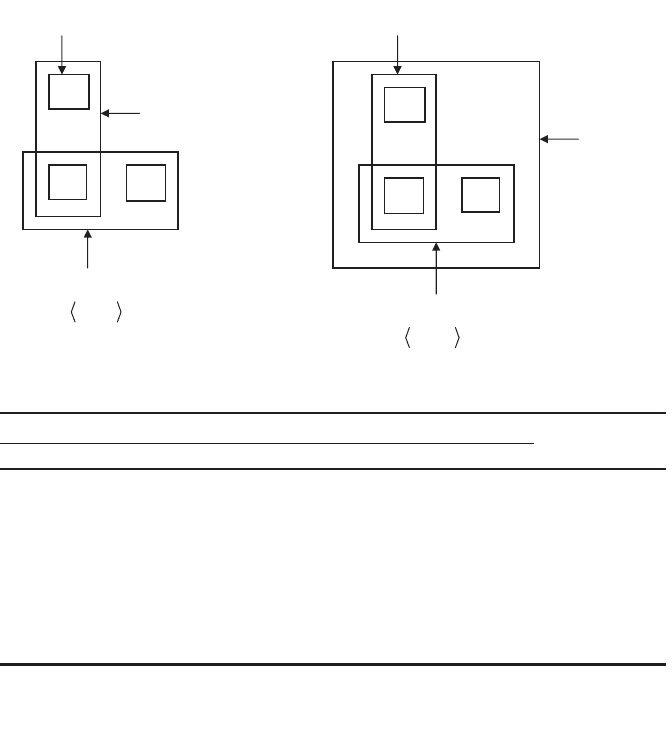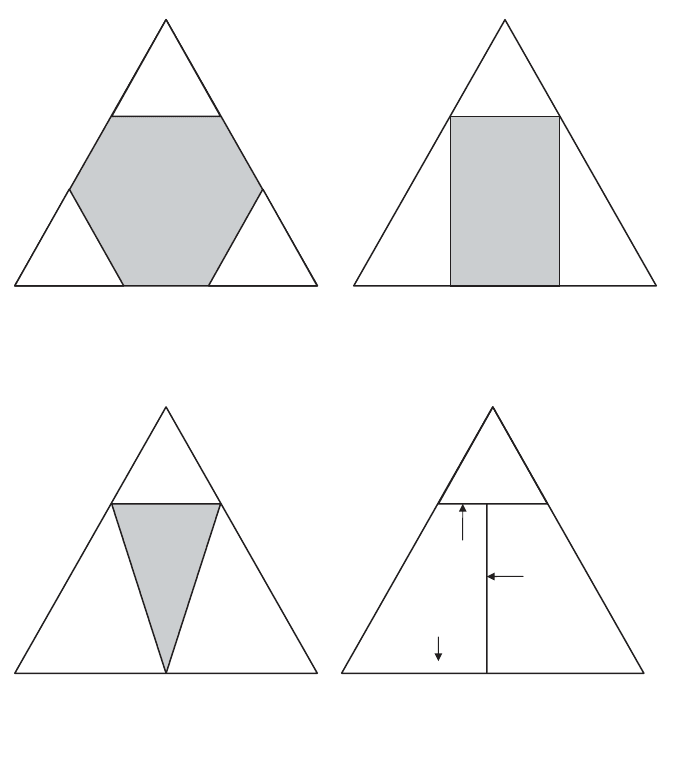Klir G.J. Uncertainity and Information. Foundations of Generalized Information Theory
Подождите немного. Документ загружается.


These bodies of evidence are also shown graphically in Figure 6.5a and 6.5b,
respectively.To determine whether ·F
1
, m
1
Ò£·F
2
, m
2
Ò, the three requirements,
(a)–(c), for ordering bodies of evidence in DST must be checked. Require-
ment (a) is trivially satisfied, since X ŒF
2
. Requirement (b) also satisfied for
{x
1
, x
3
} ŒF
2
,{x
1
, x
3
} ŒF
1
; for {x
2
, x
3
} ŒF
2
,{x
2
} ŒF
1
; for X ŒF
2
, each set in F
1
sat-
isfies the condition. Requirement (c) is satisfied by constructing a function f
that satisfies Eqs. (6.31) and (6.32). For the given bodies of evidence, such a
function is shown in the table in Figure 6.5c. For clarity, all zero entries in the
table are left blank.
Using the introduced ordering of bodies of evidence in DST, the monoto-
nicity requirement for the GH measure can be stated as follows:
212 6. MEASURES OF UNCERTAINTY AND INFORMATION
A
∆ }{
1
x }{
2
x }{
3
x },{
21
xx },{
31
xx },{
32
xx
X
)(
1
Am
0.2 0.2 0.6
B
)(
2
Bm
∆
}{
1
x
}{
2
x
}{
3
x
},{
21
xx
0.5
}
,{
31
xx
0.5
0.1
}
,{
32
xx
0.1
f(A,B)
0.1 0.2 0.1 X 0.4
(c)
2
x
1
x
3
x
2
x
3
x
1
x
2.0})({
21
=
xm
2.0}),({
211
=
xxm
6.0}),({
311
=
xxm
11
, m
F
(a)
1.0}),({
322
=
xxm
4.0)(
2
=
Xm
5.0}),({
312
=
xxm
22
, m
F
(b)
Figure 6.5. Illustrations of ordered bodies of evidence in DST (Example 6.5).

As is stated by the following theorem, the functional GH defined by Eq. (6.27)
satisfies this monotonicity.
Theorem 6.4. For any pair of bodies of evidence in DST, ·F
1
, m
1
Ò and ·F
2
, m
2
Ò,
and for the functional GH defined by Eq. (6.27),
(6.33)
Proof
䊏
6.3.3. Conditional Generalized Hartley Measures
The GH measure defined by Eq. (6.27) is basically a weighted average of the
Hartley measure. Its conditional counterparts should thus be weighted aver-
ages of the respective conditional Hartley measures. It is thus meaningful to
define GH(X|Y) and GH(Y |X) by the formulas
(6.34)
(6.35)
where B 債 Y and A 債 X.
Now, Eq. (6.34) can be rewritten as
GH X Y m C C m C B
GH X Y m C B
GH X Y m C B
GH X Y m B B
CXY CXY
CXY
CXYBY
Y
BY
()
=
()
-
()
=¥
()
-
()
=¥
()
-
()
=¥
()
-
()
Õ¥ Õ¥
Õ¥
Õ¥Õ
Õ
ÂÂ
Â
ÂÂ
Â
log log
log
log
log .
22
2
2
2
GH Y X m C
C
A
CXY
()
=
()
Õ¥
Â
log ,
2
GH X Y m C
C
B
CXY
()
=
()
Õ¥
Â
log ,
2
mA A fAB A
fAB B
fAB B
mB B
AX BABAX
BA BAX
AA BBX
BX
12 2
2
2
22
()
=
()
£
()
=
()
=
()
ÕÕÕ
ÕÕ
ÕÕ
Õ
ÂÂÂ
ÂÂ
ÂÂ
Â
log , log
, log
, log
log .
FF
11 22 1 2
,, .mmGHmGHm£fi
()
£
()
if then FF
11 22 1 2
,,, .mmGHmGHm£
()
£
()
6.3. GENERALIZED HARTLEY MEASURE IN DEMPSTER–SHAFER THEORY 213

Hence,
(6.36)
and by a similar derivation,
(6.37)
These equations verify once more that the relationship among joint, marginal,
and conditional uncertainties is an invariant property of the uncertainty
theories.
6.4. GENERALIZED HARTLEY MEASURE FOR CONVEX SETS OF
PROBABILITY DISTRIBUTIONS
It is desirable to try to generalize the Hartley functional in DST to arbitrary
convex sets of probability distributions (credal sets). This generalized version
of the functional would be defined by the formula
(6.38)
where D is a given set of probability distributions on X. Function m
D
in this
formula is obtained by the Möbius transformation applied to the lower prob-
ability function that is derived from D via Eq. (4.11).
It is easy to show that this functional GH is additive. That is,
(6.39)
when D is derived from D
X
and D
Y
that are noninteractive, which means that
for all A ŒP(X) and all B Œ P(Y),
(6.40)
and m
D
(C) = 0 for all C π A ¥ B. The proof of additivity of functional GH in
this generalized case is virtually the same as the proof of additivity of GH in
DST (the proof of Theorem 6.3). Although values m
D
(A) in Eq. (6.38) may be
negative for some subsets of X, the equation
upon which the proof is based, still holds.
It is clear that the GH functional has the proper range, [0, log
2
|X|],
when the units of measurement are bits: 0 is obtained when D contains a single
mA
AX
D
()
=
Õ
Â
1,
mAB m Am B
XY
DDD
¥
()
=
()
◊
()
GH GH GH
XX YY
DD D
()
=
()
+
()
,
GH m A A
AX
D
D
()
=
()
Õ
Â
log ,
2
GH Y X GH X Y GH X
()
=¥
()
-
()
.
GH X Y GH X Y GH Y
()
=¥
()
-
()
,
214 6. MEASURES OF UNCERTAINTY AND INFORMATION

probability; log
2
|X| is obtained when D contains all possible probability
distributions on X, and thus represents total ignorance. The functional GH is
also continuous, symmetric (invariant with respect to permutations of the
probability distributions in D), and expansible (it does not change when com-
ponents with zero probabilities are added to the probability distributions
in D).
One additional property of the generalized Hartley functional, which is
significant when we deal with credal sets, is its monotonicity with respect to
subsethood relationship between credal sets. This means that for every pair
of credal sets on X,
i
D and
j
D, if
i
D 債
j
D then GH(
i
D) £ GH(
j
D). This
property, whose proof is available in the literature (Note 6.6), is illustrated by
the following example.
EXAMPLE 6.6. Consider six convex sets of probability distributions on X =
{x
1
, x
2
, x
3
} , which are denoted by
i
D(i Œ ⺞
6
) and are defined geometrically
in Figure 6.6. Clearly,
1
D 傶
2
D 傶
3
D 傶
4
D and also
3
D 傶
5
D. However,
6
D is neither a subset nor a superset of any of the other sets. For each set
i
D(i Œ⺞
6
), the associated lower probability function,
i
m,
–
its Möbius represen-
tation,
i
m, and the value GH(
i
D) of the GH measure are shown in Table 6.1.
In conformity with the monotonicity of GH,
and also GH(
3
D) ≥ GH(
5
D). Moreover, GH(
6
D) ≥ GH(
i
D) for all i Œ ⺞
5
,
which illustrates that nonspecificity GH(D) does not express the size of D.
While subadditivity of the generalized Hartley functional has been proven
for all uncertainty theories that are subsumed under DST (Theorem 6.2), the
following example demonstrates that the functional is not subadditive for arbi-
trary convex sets of probability distributions.
EXAMPLE 6.7. Let X = {x
1
, x
2
} and Y = {y
1
, y
2
} , and let z
ij
=·x
i
, y
j
Ò for all i, j
Œ {1, 2} . Furthermore, let p =·p
11
, p
12
, p
21
, p
22
Ò denote joint probability distri-
butions on X ¥ Y, where p
ij
= p(z
ij
). Given the set D of all convex combina-
tions of probability distributions p
A
=·0.4, 0.4, 0.2, 0Ò and p
B
=·0.6, 0.2, 0, 0.2Ò,
we obtain the associated sets D
X
= {·0.8, 0.2Ò} and D
Y
= {·0.6, 0.4Ò} of marginal
probability distributions. Clearly, GH(D
X
) + GH(D
Y
) = 0. The lower proba-
bility function, m
–
D
associated with D and its Möbius representation, m
D
, are
shown in Table 6.2. Clearly, GH(D) = 0.332. Hence, GH is not subadditive in
this example.
It is easy to determine that the lower probability function m
–
D
in Example
6.7 is not 2-monotone. It contains eight violations of 2-monotonicity. One of
them is the violation of the inequality
mmmm
DDDD
zzz zz zz z
11 12 21 11 12 11 21 11
,, , , .
{}()
≥
{}()
+
{}()
-
{}()
GH GH GH GH
1234
DDDD
()
≥
()
≥
()
≥
()
6.4. GENERALIZED HARTLEY MEASURE FOR CONVEX SETS 215

Indeed, 0.8 ≥/ 0.8 + 0.6 - 0.4. Whether GH is subadditive or not for some less
general credal sets is an open question. However, this question looses its
significance within the context discussed in Section 6.8.
6.5. GENERALIZED SHANNON MEASURE IN
DEMPSTER–SHAFER THEORY
The issue of how to generalize the Shannon entropy from probability theory
to DST has been discussed in the literature since the early 1980s. By and large,
216 6. MEASURES OF UNCERTAINTY AND INFORMATION
0.5, 0.5, 0
1/3, 0, 2/3 0, 1/3, 2/3 1/3, 0, 2/3 0, 1/3, 2/3
1/3, 2/3, 0 2/3, 1/3, 0
1/3, 0, 2/3 0, 1/3, 2/3
1, 0, 0
1, 0, 0 1, 0, 0 0, 1, 0 0, 1, 0
0, 1, 0
0, 0, 1 0, 0, 1
0, 0, 1
0, 2/3, 1/3
0, 1, 0 1/3, 2/3, 0 2/3, 1/3, 0 1, 0, 0
2/3, 0, 1/3
1/3, 0, 2/3 0, 1/3, 2/3
0, 0, 1
D
1
D
2
D
3
D
5
D
6
D
4
1/6, 1/6, 2/3
(a) (b)
(d)
0.5, 0.5, 0
(c)
Figure 6.6. Closed convex sets of probability distributions on X = {x
1
, x
2
, x
3
} discussed in
Example 6.6.

Table 6.1 Lower Probability Functions and Their Möbius Representations for the Convex Sets of Probability Distributions on X = {x
1
, x
2
, x
3
}
Defined in Figure 6.6 and the Associated Values of the Generalized Hartley Measure GH (Example 6.6)
x
1
x
2
x
3
1
D
2
D
3
D
4
D
5
D
6
D
1
m
¯
1
m
2
m
¯
2
m
3
m
¯
3
m
4
m
¯
4
m
5
m
¯
5
m
6
m
¯
6
m
A:000000000 00000 0
100000000 1/61/6000 0
010000000 1/61/6000 0
001000000 002/32/30 0
1 1 0 1/3 1/3 1/3 1/3 1/3 1/3 1/3 0 1/3 1/3 1 1
1 0 1 1/3 1/3 1/3 1/3 0.5 0.5 0.5 1/3 2/3 0 0 0
0 1 1 1/3 1/3 1/3 1/3 0.5 0.5 0.5 1/3 2/3 0 0 0
11110101-1/310101 0
GH(
i
D) 1 1 0.805 2/3 1/3 1
217

the prospective generalized Shannon entropy was viewed in these discussions
as a measure of conflict among evidential claims in each given body of evi-
dence in DST. This view was inspired by the recognition that the Shannon
entropy itself is a measure of conflict associated with each given probability
distribution (recall the discussion of Eq. (3.25) in Chapter 3).
Although several intuitively promising functionals have been proposed as
candidates for the generalized Shannon entropy in DST, each of them was
found upon closer scrutiny to violate some of the essential requirements for
uncertainty measures. In most cases, it was the requirement of subadditivity,
perhaps the most fundamental requirement, that was violated. The efforts to
determine a justifiable generalization of the Shannon entropy in DST have
thus been unsuccessful.The reasons for this failure, which are now understood,
are explained later in this section.
Although none of the functionals proposed as a prospective generalization
of the Shannon entropy in DST is acceptable on mathematical grounds, it
seems useful to present their overview for at least two reasons: (1) ideas are
always better understood when we are familiar with the history of their devel-
opment; and (2) knowing which of the promising candidates have failed will
avoid their “reinventing.”
In the following overview of the unsuccessful attempts to generalize the
Shannon entropy to DST, no references are made.The relevant references are
all given in Note 6.7.
Two of the candidates for the generalized Shannon entropy in DST were
proposed in the early 1980s. One of them is functional E defined by the
formula
218 6. MEASURES OF UNCERTAINTY AND INFORMATION
Table 6.2. Lower Probability Function m
¯
D
in Examples 6.7 and 6.13
z
11
z
12
z
21
z
22
m
¯
D
(A) m
D
(A)
A: 0 0 0 0 0.0 0.0
1 0 0 0 0.4 0.4
0 1 0 0 0.2 0.2
0 0 1 0 0.0 0.0
0 0 0 1 0.0 0.0
1 1 0 0 0.8 0.2
1 0 1 0 0.6 0.2
1 0 0 1 0.4 0.0
0 1 1 0 0.2 0.0
0 1 0 1 0.4 0.2
0 0 1 1 0.2 0.2
1 1 1 0 0.8 -0.2
1 1 0 1 0.8 -0.2
1 0 1 1 0.6 -0.2
0 1 1 1 0.4 -0.2
1 1 1 1 1.0 0.4

(6.41)
which is usually called a measure of dissonance. The other one is functional C
defined by the formula
(6.42)
which is referred to as a measure of confusion. It is obvious that both of these
functionals collapse into the Shannon entropy when m defines a probability
measure.
To decide if either of the two functionals is an appropriate generalization
of the Shannon entropy in DST, we have to determine what these functionals
actually measure. From Eq. (5.47) and the general property of basic probabil-
ity assignments (satisfied for every A ΠP(X)),
(6.43)
we obtain
(6.44)
The term
in Eq. (6.44) represents the total evidential claim pertaining to focal elements
that are disjoint with the set A. That is, K(A) expresses the sum of all evi-
dential claims that fully conflict with the one focusing on the set A. Clearly,
K(A) Π[0, 1]. The function
which is employed in Eq. (6.44), is monotonic increasing with K(A), and
extends its range from [0, 1] to [0, •). The choice of the logarithmic function
is motivated in the same way as in the classical case of the Shannon entropy.
It follows from these facts and the form of Eq. (6.44) that E(m) is the mean
(expected) value of the conflict among evidential claims within a given
body of evidence ·F, mÒ; it measures the conflict in bits and its range is
[0, log
2
|X|].
Functional E is not fully satisfactory since we feel intuitively that m(B) may
conflict with m(A) not only when B « A =∆. This broader view of conflict is
--
()
[]
log ,
2
1 KA
KA mB
AB
()
=
()
«=∆
Â
Em mA mB
ABA
()
=-
()
-
()
Ê
Ë
ˆ
¯
«=∆Œ
ÂÂ
log .
2
1
F
mB mB
AB AB
()
+
()
=
«=∆ «π∆
ÂÂ
1,
C m m A Bel A
A
()
=-
() ()
Œ
Â
log ,
2
F
E m m A Pl A
A
()
=-
() ()
Œ
Â
log ,
2
F
6.5. GENERALIZED SHANNON MEASURE IN DEMPSTER–SHAFER THEORY 219

expressed by the measure of confusion C given by Eq. (6.42). Let us demon-
strate this fact.
From Eq. (5.46) and the general property of basic assignments (satisfied for
every A ŒP(X)),
(6.45)
we get
(6.46)
The term
in Eq. (6.46) expresses the sum of all evidential claims that conflict with
the one focusing on the set A according to the following broader view of
conflict: m(B) conflicts with m(A) whenever B À
¯
A. The reason for using the
function
instead of L(A) in Eq. (6.46) is the same as already explained in the context
of functional E. The conclusion is that C(m) is the mean (expected) value of
the conflict, viewed in the broader sense, among evidential claims within a
given body of evidence ·F, mÒ.
Functional C is also not fully satisfactory as a measure of conflicting
evidential claims within a body of evidence, but for a different reason than
functional E. Although it employs the broader, and more satisfactory, view
of conflict, it does not properly scale each particular conflict of m(B) with
respect to m(A) according to the degree of violation of the subsethood
relation B 債 A. It is clear that the more this subsethood relation is violated,
the greater the conflict. In addition, neither E nor C satisfy the essential
axiomatic requirement of subadditivity.
To overcome the deficiencies of functionals E and C as adequate measures
of conflict in evidence theory, a new functional, D, was proposed in the early
1990s:
(6.47)
Observe that the term
Dm mA mB
BA
B
BA
()
=-
()
-
()
-
Ê
Ë
Á
ˆ
¯
˜
ŒŒ
ÂÂ
log .
2
1
FF
--
()
[]
log
2
1 LA
LA mB
BA
()
=
()
Â
債
Cm mA mB
BAA
()
=-
()
-
()
Ê
Ë
Á
ˆ
¯
˜
ÂÂ
Œ
log .
2
1
債
F
mB mB
BA BA
()
+
()
=
Õ
ÂÂ
債
1
220 6. MEASURES OF UNCERTAINTY AND INFORMATION

(6.48)
in Eq. (6.47) expresses the sum of individual conflicts of evidential claims with
respect to a particular set A, each of which is properly scaled by the degree to
which the subsethood B 債 A is violated. This conforms to the intuitive idea of
conflict that emerged from the critical reexamination of functionals E and C.
Clearly, Con(A) Π[0, 1] and, furthermore,
(6.49)
The reason for using the function
instead of Con in Eq. (6.47) is exactly the same as previously explained in the
context of functional E. This monotonic transformation extends the range of
Con(A) from [0, 1] to [0, •).
Functional D, which is called a measure of discord, is clearly a measure of
the mean conflict (expressed by the logarithmic transformation of function
Con) among evidential claims within each given body of evidence. It follows
immediately from Eq. (6.49) that
(6.50)
Observe that |B - A|=|B|-|A « B| and, consequently, Eq. (6.47) can be
rewritten as
(6.51)
It is obvious that
(6.52)
Although functional D is intuitively more appealing than functionals E and
C, further examination revealed that it has a conceptual defect.To explain the
defect, let sets A and B in Eq. (6.47) be such that A Ã B. Then, according to
function Con, the claim m(B) is taken to be in conflict with the claim m(A) to
the degree |B - A|/|B|. This, however, should not be the case: the claim focus-
ing on B is implied by the claim focusing on A (since A Ã B) and, hence, m(B)
should not be viewed in this case as contributing to the conflict with m(A).
Consider, as an example, incomplete information regarding the age of a
person, say Joe. Assume that the information is expressed by two evidential
Bel A m B
AB
B
Pl A
B
()
£
()
«
£
()
Œ
Â
F
.
Dm mA mB
AB
B
BA
()
=-
() ()
«
ŒŒ
ÂÂ
log .
2
FF
Em Dm Cm
()
£
()
£
()
.
--
()
[]
log
2
1 Con A
K A Con A L A
()
£
()
£
()
.
Con A m B
BA
B
B
()
=
()
-
Œ
Â
F
6.5. GENERALIZED SHANNON MEASURE IN DEMPSTER–SHAFER THEORY 221
